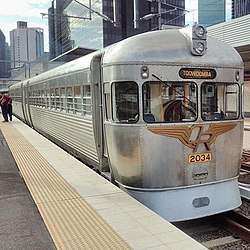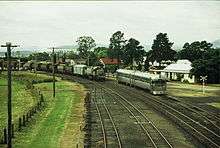Queensland Railways 2000 class rail motor
The 2000 class railcars are a class of self-propelled railcars built by Commonwealth Engineering, Rocklea for the Queensland Railways between 1956 and 1971.
| Queensland Railways 2000 class railmotor | |
|---|---|
 2000 class on a railtour to Toowoomba in September 2018 | |
| In service | 1956 - Present |
| Manufacturer | North Ipswich Railway Workshops Commonwealth Engineering |
| Built at | Ipswich Rocklea |
| Constructed | 1956-1971 |
| Number built | 42 |
| Number in service | 5 in regular use, 3 preserved units available for mainline charters |
| Number preserved | 19 |
| Number scrapped | 15 |
| Formation | Up to four cars |
| Fleet numbers | 2000-2034, 2036, 2038, 2040, 2051, 2053, 2055, 2057 |
| Capacity | 54 passengers 42 passengers (with luggage compartment) 52 passengers (intermediate cars) |
| Operator(s) | Queensland Railways, Aurizon |
| Depot(s) | Ipswich, Townsville, Mayne (when required) |
| Specifications | |
| Car length | 55 ft (17 m) |
| Width | 8 ft 6 in (2.59 m) |
| Height | 5 ft 6 in (1.68 m) |
| Entry | Platform level and step |
| Doors | 2 |
| Wheel diameter | 2 ft 6 in (0.76 m) |
| Wheelbase | 6 ft 6 in (1.98 m) |
| Maximum speed | 50 mph (80 km/h) |
| Weight | 21.3 t (21.0 long tons; 23.5 short tons) (2000-2001) 22 t (22 long tons; 24 short tons) (2002-2057) |
| Prime mover(s) | 125 hp (93 kW) AEC (2000-2001) 150 hp (110 kW) Rolls-Royce (2002-2057) |
| Coupling system | Screw and Hook, Emergency attachable coupler |
| Multiple working | Within Class |
| Track gauge | 1,067 mm (3 ft 6 in) |
History

In 1956 two 2000 class railmotor prototypes were constructed by Queensland Railways at its Ipswich Railway Workshops sheeted in satin finished aluminium. They were powered by 125 hp (93 kW) AEC engines.[1][2]
In 1959 ten units were ordered from Commonwealth Engineering. These differed from the prototypes in having sheeted stainless steel and 150 hp (110 kW) Rolls-Royce engines. In 1963 a further five were ordered, followed in 1971 by a further ten.[1] The last four were completed as Passenger Luggage Driving Trailers with access doors at both ends instead of a streamlined front, allowing the formation of 3-car (and occasionally 4-car) trains.
They operated services around Brisbane as well as being allocated to Mackay, Townsville and Cairns.[2]
Most were withdrawn in the early 1990s, with the last operating in regular service on the Corinda-Yeerongpilly line in January 2000.[3]
Queensland Rail retains 9 units, of which three operate The Savannahlander tourist train,[4] three are operational with the QR Heritage Division (and occasionally used by Queensland Rail for track inspections) and three are stored at Ipswich Workshops. Aurizon inherited two units from QR National which are used for track inspections. Many others are preserved.
Summary
| Key: | In Service | Withdrawn | Preserved | Scrapped |
|---|
| Number | In service | Withdrawn | Scrapped | Current owner | Notes |
|---|---|---|---|---|---|
| RM2000 | 10 May 1956 | 8 April 1987 | Some time after 2004 | Prototype Cars | |
| RM2001 | 21 December 1956 | 8 April 1987 | Some time after 2004 | Prototype Cars | |
| RM2002 | 12 May 1960 | 12 November 1988 | Private | Stored | |
| RM2003 | 12 May 1960 | 18 January 1989 | June 1996 | ||
| RM2004 | 14 July 1960 | Aurizon | Used for track inspections. | ||
| RM2005 | 14 July 1960 | 1 July 2000 | Queensland Rail Heritage Division | Stored | |
| RM2006 | 26 October 1960 | 30 December 1993 | Zig Zag Railway | Repairs in progress | |
| RM2007 | 26 October 1960 | 30 September 1992 | Private | Stored | |
| RM2008 | 28 November 1960 | 7 February 1989 | Zig Zag Railway | Stored | |
| RM2009 | 28 November 1960 | 3 April 1989 | Private | Stored | |
| RM2010 | 12 January 1961 | 2 December 1988 | June 1995 | ||
| RM2011 | 12 January 1961 | 1 April 1994 | Zig Zag Railway | Repairs in progress | |
| RM2012 | 11 February 1961 | 6 February 1989 | Private | Body preserved at Station Road Cafe, Station Road Yeerongpilly. | |
| RM2013 | 11 February 1961 | 29 January 1975 | December 1976 | ||
| RM2014 | 7 March 1961 | 13 June 1989 | Mount Morgan Railway Museum | Static | |
| RM2015 | 7 March 1961 | 20 January 1989 | June 1995 | ||
| RM2016 | 30 March 1961 | 25 June 1991 | 2018 | Zig Zag Railway | Burnt in 2013 New South Wales bushfires. |
| RM2017 | 30 March 1961 | 31 December 1993 | Mary Valley Heritage Railway | Operational | |
| RM2018 | 5 May 1961 | 20 January 1989 | June 1995 | ||
| RM2019 | 5 May 1961 | 20 January 1989 | June 1995 | ||
| RM2020 | 5 June 1961 | 17 January 1989 | Zig Zag Railway | Stored | |
| RM2021 | 5 June 1961 | 29 March 1989 | Private | Stored | |
| RM2022 | 22 March 1963 | 30 December 1993 | June 1995 | ||
| RM2023 | 22 March 1963 | 31 December 1993 | Mary Valley Heritage Railway | Operational | |
| RM2024 | 26 April 1963 | 1 July 2000 | Queensland Rail Heritage Division | Stored | |
| RM2025 | 26 April 1963 | 7 August 1989 | Private | Stored | |
| RM2026 | 10 May 1963 | Queensland Rail | Leased to Cairns Kuranda Steam to operate the Savannahlander | ||
| RM2027 | 10 May 1963 | 30 December 1993 | June 1995 | ||
| RM2028 | 14 June 1963 | Queensland Rail | Leased to Cairns Kuranda Steam to operate the Savannahlander | ||
| RM2029 | 14 June 1963 | 30 December 1993 | June 1995 | ||
| RM2030 | 1 June 1963 | 9 May 1991 | June 1995 | ||
| RM2031 | 1 June 1963 | 1 July 2000 | Queensland Rail Heritage Division | Stored. | |
| RM2032 | 17 December 1970 | Aurizon | Used for track inspections. | ||
| RM2033 | 17 December 1970 | 30 December 1993 | Australian Railway Historical Society | Rosewood Railway Museum | |
| RM2034 | 10 January 1971 | 1 July 2000 | Queensland Rail Heritage Division | Operational, main line registered. Also used for track inspections. | |
| RM2036 | 10 January 1971 | 1 July 2000 | Queensland Rail Heritage Division | Operational, main line registered. Also used for track inspections. | |
| RM2038 | 20 April 1971 | 4 January 1994 | Australian Railway Historical Society | Rosewood Railway Museum | |
| RM2040 | 20 April 1971 | 5 October 1990 | June 1995 | ||
| RM2051 | 11 February 1971 | 5 January 1994 | Zig Zag Railway | Repairs in progress | |
| RM2053 | 11 February 1971 | Queensland Rail | Leased to Cairns Kuranda Steam to operate the Savannahlander | ||
| RM2055 | 15 March 1971 | 1 October 1993 | 2018 | Zig Zag Railway | Burnt in 2013 bushfires |
| RM2057 | 15 March 1971 | 1 July 2000 | Queensland Rail Heritage Division. | Operational, has received a new engine and some new internal modifications; including Disabled Access and Toilet facilities. Main line registered |
References
- "2000 Class Railmotors" The Workshops Rail Museum 23 October 2003
- Dunn, John (2010). Comeng: A History of Commonwealth Engineering Volume 2: 1955-1966. Kenthurst: Rosenberg Publishing. pp. 87–89, 95–100. ISBN 1877058734.
- "QR ICE Set Controversy" Railway Digest March 2000 page 14
- Rollingstock Archived 24 January 2014 at the Wayback Machine Savannahlander